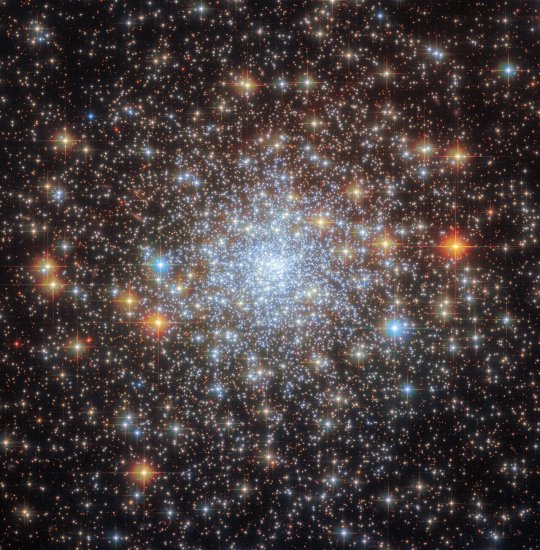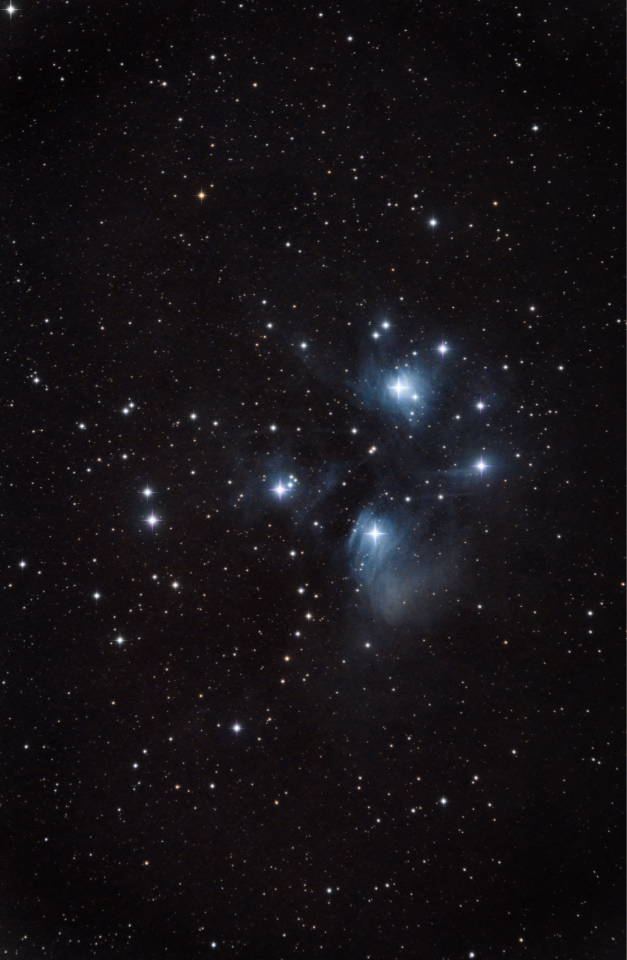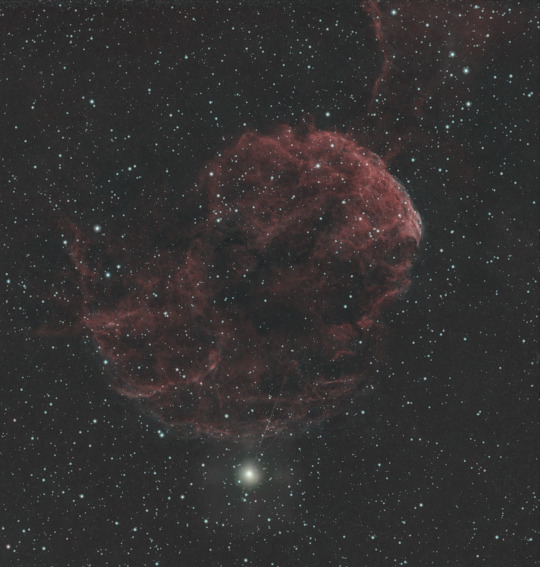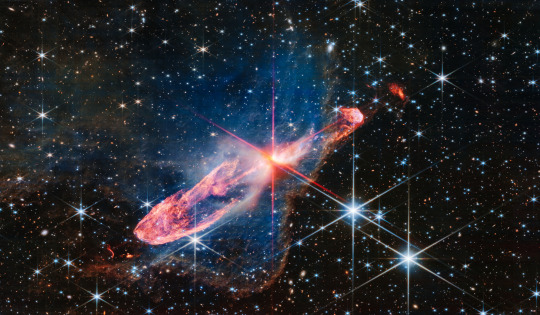#diffraction spikes
Explore tagged Tumblr posts
Text





"Webb's Diffraction Spikes Extended Description
This is a diagram labeled “Webb’s Diffraction Spikes”. The top right of the image shows three stars producing eight-pronged diffraction spike patterns. This diagram is composed of five sections.
The first section is headlined “What Are Diffraction Spikes?” Below the headline is a caption that says, “Have you ever noticed that bright stars in your favorite space images have unique spikes around them? These are known as diffraction spikes. Diffraction spikes are patterns produced as light bends around the sharp edges of a telescope. While all stars can create these patterns, we only see spikes with the brightest stars when a telescope takes an image. For most reflecting telescopes, including Webb, diffraction spikes appear when light interacts with the primary mirror and struts that support the secondary mirror.” Below this is an image of Webb’s observing side, including its 18 gold hexagonal segments, science instruments, primary mirror, struts and secondary mirror.
The second section is headlined “How Does Diffraction Happen?” Underneath this headline is a caption that says, “Light, which has wave-like properties, tends to radiate from a central point outward, similar to how water behaves when a stone is tossed into it. As light encounters an edge, it is bent and redirected, sending it in different directions. In situations where these light waves meet and interact, they can either become more amplified or cancel each other out. These areas of amplification and cancellation form the light and dark spots that show in diffraction patterns.” Underneath this caption are two boxes, lined horizontally. The first box, on the left, is a star that displays Hubble’s Diffraction Pattern, which has four-points – two vertical and two horizontal points. The second box, on the right, is a star that displays Webb’s Diffraction Pattern, which has eight-points – two vertical, two horizontal and four diagonal points.
The third section is headlined, “Primary Mirror Influence”. Underneath this headline is a caption that says, “Primary mirrors in reflecting telescopes cause light waves to interact as they direct light to the secondary mirror. So, even if a telescope had no struts, it would still create a diffraction pattern. The shape of the primary mirror, in particular the number of edges it has, determines the mirror’s diffraction pattern. Light waves interact with those edges to create perpendicular diffraction spikes.” Underneath this caption are six images, broken into rows of three. The first three are labeled, “Primary Mirror Shape”, which display a circle, square and hexagonal shape, like Webb’s, in white. The last three are labeled, “Image of Point Source”, and display the patterns due to the “Primary Mirror Shape” underneath. The first displays a diffraction pattern with a solid, bright center and alternating dark and light circles. The next shows a six-pointed spike pattern with alternating bright and dark regions. The last shows a complex fractal of light and dark regions within eight spikes – the closest representation to Webb’s.
The fourth section is headlined, “Strut Influence”. Underneath this is a caption, which describes the graphic below it, and says, “The number and position of struts holding up the secondary mirror determine the struts’ diffraction spike pattern. In the first row, there is a set of struts organized in a single line. When light hits a strut, the light bends into a single, perpendicular pattern of amplified and cancelled light (represented by a yellow dashed line). In the second row, a second set of struts is added to the first, creating a second, perpendicular diffraction spike (represented by a red dashed line). In the third row, there are three struts with two of them at an angle. In this case, there would be three diffraction spikes, with each spike perpendicular to a strut (represented by yellow, red, and blue dashed lines).”
The last section is headlined, “Webb’s Eight-Pointed Stars”. Underneath the headline is a caption that says, “Like most reflecting telescopes, the diffraction spikes for Webb are defined by its primary mirror and struts. Webb has three struts, with two angled at 150 degrees from its vertical strut, and its primary mirror is composed of hexagonal segments that each contain edges for light to diffract against. Webb’s struts are designed so that their diffraction spikes partially overlap with those created by the mirrors. Both of these lead to Webb’s complex eight-pointed star pattern.” At the bottom of this diagram is Webb’s eight-pointed star pattern organized by its “Strut Influence”, which overlaps parts of the star with red borders, and its primary mirror influence, which overlaps parts of the star with yellow borders. Above this image are more images that show the Webb’s segmented primary mirror and struts, with the primary mirror’s borders highlighted yellow and its struts highlighted red."
https://webbtelescope.org/contents/media/images/01G529MX46J7AFK61GAMSHKSSN
#diffraction spikes#stars#space stuff#nasa#james webb space telescope#jwst#hubble space telescope#hubble telescope#light#physics#astrophysics#telescopes
4 notes
·
View notes
Note
the blue and orange things are relatively nearby stars! due to the shape of the james webb space telescope's mirrors, a six-pointed star of diffraction spikes is formed. pictures from the hubble space telescope have four-pointed stars, likewise because of how hubble's mirror is shaped
(wrt this post)
:O!!!!! thank you so much, I was actually very curious!! that's so cool to know :> oohnow I feel like I have to pick a favorite btw 4 points and 6 points hehe
#asks#LOVE love the nice swoops of 4 point starts but these 6 point diffraction spikes....could be a game changer for me
1 note
·
View note
Text

Hubble Sees a Spiral and a Star by NASA Hubble Space Telescope
This NASA/ESA Hubble Space Telescope image features a sparkling spiral galaxy paired with a prominent star, both in the constellation Virgo. While the galaxy and the star appear to be close to one another, even overlapping, they’re actually a great distance apart. The star, marked with four long diffraction spikes, is in our own galaxy. It’s just 7,109 light-years away from Earth. The galaxy, named NGC 4900, lies about 45 million light-years from Earth.
168 notes
·
View notes
Text

The glittering, glitzy contents of the globular cluster NGC 6652 sparkle in this star-studded image from the NASA/ESA Hubble Space Telescope. The core of the cluster is suffused with the pale blue light of countless stars, and a handful of particularly bright foreground stars are adorned with crisscrossing diffraction spikes. NGC 6652 lies in our own Milky Way galaxy in the constellation Sagittarius, just under 30,000 light-years from Earth and only 6,500 light-years from the galactic center.
Image credit: ESA/Hubble & NASA, A. Sarajedini, G. Piotto
2K notes
·
View notes
Photo

2025 May 26
Spiral Galaxy NGC 2566 from Webb Image Credit: ESA/Webb, NASA & CSA, A. Leroy
Explanation: What’s happening in the center of spiral galaxy NGC 2566? First, the eight rays that appear to be coming out of the center in the featured infrared image are not real — they are diffraction spikes caused by the mechanical structure of the Webb space telescope itself. The center of NGC 2566 is bright but not considered unusual, which means that it likely contains a supermassive black hole, although currently not very active. At only 76 million light years away, the light we see from NGC 2566 today left when dinosaurs roamed the Earth. The picturesque galaxy is close enough so that Earthly telescopes, including Webb and Hubble, can resolve the turbulent clouds of gas and dust where stars can form and so allows study of stellar evolution. NGC 2566, similar in size to our Milky Way Galaxy, is notable for its bright central bar and its prominent outer spiral arms.
∞ Source: apod.nasa.gov/apod/ap250526.html
147 notes
·
View notes
Text


Alternative version of my latest M45//Pleiades//Seven Sisters photo, this one with diffraction spikes on many of the larger stars. Photo taken and processed by me. October 2024.
199 notes
·
View notes
Text
Does space have frisbees? No, but it does have spiral galaxies like NGC 2090, which has been studied with the Hubble and James Webb space telescopes.
Hubble’s visible and ultraviolet view captures the galaxy’s glowing central core, the mottled threads of brown dust, and patchy groups of stars at various formation stages that compose the galaxy’s clockwise spiral arms. Bright foreground stars with four-pointed diffraction spikes dot the scene.
In comparison, Webb’s near- and mid-infrared view shows the galaxy’s core as bright blue because of the bright starlight. The structure of the spiral arms is sharper, and tiny dust particles shown in red fall along strands of gas and dust within the arms. Foreground stars show Webb’s distinctive eight-pointed diffraction spikes (six big spikes and two smaller ones).
NGC 2090 is about 40 million light-years from Earth and located in the constellation Columba.
Credit: ESA/Webb, ESA/Hubble, NASA & CSA, A. Leroy, D. Thilker, N. Bartmann (ESA/Webb).
#space#astronomy#science#universe#hubble#nasawebb#hubble space telescope#james webb space telescope#jwst
65 notes
·
View notes
Text

This stunning image from the James Webb Space Telescope shows 50,000 sources of near-infrared light. The galaxies of Pandora’s Cluster act as a natural gravitational lens, magnifying distant galaxies from the early Universe. Some lensed sources, red in color and distorted, provide a glimpse into the past, stretching the very fabric of spacetime. A foreground star shows Webb’s unique diffraction spikes.
Credit: NASA, ESA, CSA
35 notes
·
View notes
Text

The Jellyfish Nebula - IC443 - SH2-248
45*300s in HOO
Askar 71F
ASI 533MC Pro
Askar Color Magic C1 Ha+O3
Bortle 5.5ish
This nebula is one of the most studied supernova remnants in existence, thought to be 30-35k years old. It is located in the constellation Gemini, approximately 5kly away from Earth.
It felt great to finally get out and have a great night again! My guiding was still awful and unfortunately I seem to have gotten a cat hair on the lens, causing the awful diffraction spikes on Propus, the brightest star in the image, but I'm very happy with how this turned out! Next time I get the opportunity to go out to the state park I shot this from, I'll use my other filter to capture S2 and O3 data so I can experiment with more pallettes.
49 notes
·
View notes
Text

The Carina Nebula, NGC 3372 // Christian Tarrant
The bright star with the diffraction spikes just left of center is none other than the hypergiant star η Carinae!
#astronomy#astrophotography#nebula#emission nebula#star-forming region#carina nebula#NGC 3372#star#eta carinae#carina
37 notes
·
View notes
Text
Omg I am the biggest and happiest slut for diffraction spikes hhhhhhhh ❤❤❤❤❤🌟
2 notes
·
View notes
Text
Behold NGC 2283, a barred spiral galaxy 45 million light-years away captured by James Webb Telescope

The James Webb Space Telescope has done it again! Today, NASA/ESA/CSA released Webb’s latest mesmerizing image—a breathtaking view of the barred spiral galaxy NGC 2283, located 45 million light-years away in the constellation Canis Major. This cosmic marvel, captured using Webb’s Near-Infrared Camera (NIRCam) and Mid-Infrared Instrument (MIRI), showcases the galaxy’s intricate structure, star-forming regions, and the life cycle of stars in dazzling detail.
A Glimpse into the Heart of NGC 2283
Barred spiral galaxies like NGC 2283 have a central bar of stars, acting as a cosmic highway that channels gas into the galaxy’s core, fueling star formation. Webb’s infrared eyes reveal the delicate interplay between stars, gas, and dust, bringing into focus the glowing knots of gas where new stars are being born. These dense pockets of hydrogen, ignited by stellar nurseries, illuminate the graceful spiral arms winding around the core.
The Power of Infrared Imaging
Webb observed NGC 2283 for 17 minutes, collecting data across six different infrared filters. These filters allow astronomers to peer through cosmic dust and uncover hidden details. The image reveals:
Brilliant star clusters scattered throughout the spiral arms
Polycyclic aromatic hydrocarbons (PAHs), sooty molecules that help astronomers trace cosmic chemistry
Interstellar gas clouds heated by young, massive stars
Foreground stars from our Milky Way, their diffraction spikes adding to the celestial display
A Galaxy Shaped by Stellar Explosions
NGC 2283 is no stranger to cosmic fireworks. Just over two years ago, astronomers witnessed a stellar explosion in this very galaxy. The supernova, SN 2023AXU, was a Type II supernova—the violent death of a massive star at least eight times the mass of our Sun. These spectacular explosions enrich the galaxy with elements like oxygen and sodium, seeding the next generation of stars and continuing the grand cosmic cycle.
Part of a Larger Cosmic Survey
This image is part of an ambitious Webb program (#3707) aimed at studying the intricate relationships between stars, gas, and dust in 55 nearby star-forming galaxies. By observing these galactic ecosystems, astronomers hope to unravel the mysteries of star formation and galaxy evolution, giving us deeper insights into our own Milky Way’s origins.
A Cosmic Time Machine
As we marvel at this new glimpse of NGC 2283, we are reminded that every light-year Webb’s gaze traverses is a journey back in time. This image captures NGC 2283 as it was 45 million years ago—when early primates roamed Earth and our planet was undergoing climatic shifts. Through Webb’s lens, we witness history written in the language of starlight.
Stay tuned for more stunning discoveries as Webb continues to unlock the universe’s deepest secrets. What do you see in this cosmic portrait? Share your thoughts in the comments! Visit www.jameswebbdiscovery.com for the latest discoveries.
#nasa#james webb space telescope#jwst#webb discoveries#spaceexploration#jameswebbtelescope#astronomy#stargazing
28 notes
·
View notes
Text

the (un)certain shape of stars
“Diffraction spikes are lines radiating from bright light sources, causing what is known as the starburst effect or sunstars in photographs and in vision.
In normal vision, diffraction through eyelashes – and due to the edges of the eyelids if one is squinting – produce many diffraction spikes. If it is windy, then the motion of the eyelashes cause spikes that move around and scintillate. After a blink, the eyelashes may come back in a different position and cause the diffraction spikes to jump around. This is classified as an entoptic phenomenon.
Although diffraction spikes can obscure parts of a photograph and are undesired in professional contexts, some amateur astronomers like the visual effect they give to bright stars – the "Star of Bethlehem" appearance – and even modify their refractors to exhibit the same effect.” (Wikipedia)
Harry Potter’s pregnant. Draco Malfoy’s being totally normal about it.
a lil story about pots of begonias & prenatal potions, constellations & cocoa. the things we don’t choose. (& the things we do.) ♡
drarry | word count: ~2k | rating: e
[ mpreg | accidental pregnancy | mild hurt/comfort | vignettes | happy ending ]
Harry seems tired, a bit ill. “Are you alright? You look—” “I’m pregnant.” The stoop goes a bit wobbly, Draco clinging loosely to the doorframe, a makeshift shield. Peaked, he was going to say. You look peaked. “You’re not funny,” he lands on, tucking back through the threshold, cheeks hot with embarrassment. “Malfoy.” He was never going to be able to close the door on him, not really— he’d known that as soon as he’d opened it. But even if he’d had the strength, Harry’s tone would have stayed him now. Harry’s eyes are a bit frantic, his fingers a harsh curl around the black wrought-iron railing. “I’m not joking.”
find it on ao3 here! ⋆˙⟡
#drarry#drarry fic#drarry fanfic#drarry fanfiction#lup writes#fic tag#mine#draco x harry#harry x draco#behold! the mpreg i never imagined i’d write ha#y’all— i’ll confess this one is very sweet ha#anyway#i hope very much that you like it <3#draco malfoy x harry potter#harry potter x draco malfoy
23 notes
·
View notes
Text

Under the Sea by European Space Agency
The jellyfish galaxy JO206 trails across this image from the NASA/ESA Hubble Space Telescope, showcasing a colourful star-forming disc surrounded by a pale, luminous cloud of dust. A handful of bright stars with criss-cross diffraction spikes stand out against an inky black backdrop at the bottom of the image. JO206 lies over 700 million light-years from Earth in the constellation Aquarius, and this image of the galaxy is the sixth and final instalment in a series of observations of jellyfish galaxies. Some of Hubble's other observations of these peculiar galaxies — which range from grandiose to ghostly — are available here.
140 notes
·
View notes
Text

NASA’s James Webb Space Telescope has captured a tightly bound pair of actively forming stars, known as Herbig-Haro 46/47, in high-resolution near-infrared light. Look for them at the center of the red diffraction spikes, appearing as an orange-white splotch. Herbig-Haro 46/47 is an important object to study because it is relatively young – only a few thousand years old. Star systems take millions of years to fully form. Targets like this give researchers insight into how much mass stars gather over time, potentially allowing them to model how our own Sun, which is a low-mass star, formed – along with its planetary system.
Credits: Image: NASA, ESA, CSA. Image Processing: Joseph DePasquale (STScI)
1K notes
·
View notes
Photo

2025 April 2
Jupiter and Ring in Infrared from Webb Image Credit: NASA, ESA, CSA, STScI; Processing & License: Judy Schmidt
Explanation: Why does Jupiter have rings? Jupiter's main ring was discovered in 1979 by NASA's passing Voyager 1 spacecraft, but its origin was then a mystery. Data from NASA's Galileo spacecraft that orbited Jupiter from 1995 to 2003, however, confirmed the hypothesis that this ring was created by meteoroid impacts on small nearby moons. As a small meteoroid strikes tiny Metis, for example, it will bore into the moon, vaporize, and explode dirt and dust off into a Jovian orbit. The featured image of Jupiter in infrared light by the James Webb Space Telescope shows not only Jupiter and its clouds, but this ring as well. Jupiter's Great Red Spot (GRS) -- in comparatively light color on the right, Jupiter's large moon Europa -- in the center of diffraction spikes on the left, and Europa's shadow -- next to the GRS -- are also visible. Several features in the image are not yet well understood, including the seemingly separated cloud layer on Jupiter's right limb.
∞ Source: apod.nasa.gov/apod/ap250402.html
134 notes
·
View notes